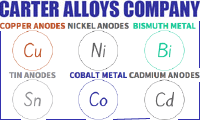
-----
Iron nickel alloy plating
Q. I am interested to know whether iron nickel alloys are normally plated using baths with iron nickel alloy anodes or with a ratio of individual iron and nickel anodes equivalent to the required deposit composition e.g. 60/40%..
Alfred Snowman- Orangeburg, New York
1999
A. I am assuming that your question involves nickel -iron alloy deposition, i.e., there is more nickel in the deposit than iron. When the nickel-iron processes first came on the market there was work done using ferro-nickel alloy cones available from Falconbridge as the anode material. Ultimately we went the use of separate baskets of iron and nickel as this was the most economical approach and easiest way to control the alloy deposition. We found the use of clean steel stamping scrap to be quite suitable for the process we were using. The number of baskets containing iron will be dictated by the amount of iron you ultimately want in the alloy deposit. Do not mix iron and nickel in the same anode basket. Most of the major suppliers have nickel-iron technology in their arsenals and they can help you. Trust this helps

Ken Lemke
Burlington, Ontario, Canada
1999
Discolouration of plated nickel/iron
Q. I am currently plating nickel and iron using a sulphate, chloride, boric acid solution. However, on some but not all plating the plated area has a brown film (looks maybe like an oxide layer?). It cannot be removed with standard cleaning. I think this layer is forming when I remove the sample from the bath and remove the resist layer. Any ideas what might be causing it?
Thank you, Tom
Tom KendalStudent - Cambridge, Cambridgeshire, UK
2003
A. Perhaps you would like to explain exactly what you are doing. Your mention of resist suggests some aspect of electroforming, or patterned electroplating, but that is not clear. A brown deposit suggests Fe(III) species to be present, as most nickel salts are greenish. As you will be aware, there can be a reversal in relative electronegativities when plating Group 8 transition metals due to the relative stability of their cationic hydrate intermediates. This will affect the composition of any electrodeposits. Furthermore, there can be complications introduced by the variation in current densities in a cathodic working electrode that will result in variations in the composition of any deposit. Why do you think the brown layer is formed when you remove the workpiece from the bath and remove the resist layer? It is possible that you are depositing a hydrated oxide of iron that may be trapped in a nickel matrix, or are exposing the (wet) electrodeposited iron to the air.
This will very rapidly oxidise the iron to ferric oxide/hydroxide. Everyone knows that iron rusts, but very few people appreciate exactly how fast pure iron reacts in moist conditions - it is pretty fast! Alternatively, the resist stripper may be reacting with the iron.
You mention the brown stain cannot be removed by standard cleaning - what is your standard? I suggest you give more details of what you are doing and using so we can possibly help you. I would also suggest you use decent analytical tools such as XRD, EDX and Auger to analyse your deposit, then you may be able to explain what has happened.

Trevor Crichton
R&D practical scientist
Chesham, Bucks, UK
2003
RFQ: Need quote for Fe/Ni5b plating on 1008 CRS deep drawn stamping 8.1mm OAL x 3.4mm Dia. No through hole. EAV from 1.4 million to 12 million. Weight is .00082 lbs per each. Material thickness is .012".
Sabrina MitchellDeep Drawn Stamping - Holland, Michigan, USA
2007
Ed. note: This RFQ is outdated, but technical replies are welcome, and readers are encouraged to post their own RFQs. But no public commercial suggestions please ( huh? why?).
Need to plate a crucial ratio of Iron Nickel onto Copper
Q. Hello,
I have a copper workpiece [1.5 cm3; ~0,1 cubic inch ], I need to form on the metal layer of an alloy of iron and nickel
Exactly.
I need minimal 10 µm with Ni 36% Fe 64% the ratio of iron and nickel is crucial, more crucial is the Curie point of this alloy.
Advise what technology to create a layer?
- Dresden Germany
June 29, 2016
adv.: Supplier of Copper Anodes, Nickel Anodes, Bismuth Metal, & Other Metal Products for Industry & The Arts

Q, A, or Comment on THIS thread -or- Start a NEW Thread